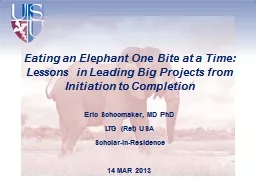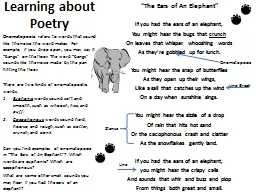PPT-Eating an Elephant One Bite at a Time: Lessons in Leading Big Projects from Initiation
Author : sherrill-nordquist | Published Date : 2020-01-22
Eating an Elephant One Bite at a Time Lessons in Leading Big Projects from Initiation to Completion Eric Schoomaker MD PhD LTG Ret USA ScholarinResidence 14 MAR
Presentation Embed Code
Download Presentation
Download Presentation The PPT/PDF document "Eating an Elephant One Bite at a Time: L..." is the property of its rightful owner. Permission is granted to download and print the materials on this website for personal, non-commercial use only, and to display it on your personal computer provided you do not modify the materials and that you retain all copyright notices contained in the materials. By downloading content from our website, you accept the terms of this agreement.
Eating an Elephant One Bite at a Time: Lessons in Leading Big Projects from Initiation: Transcript
Download Rules Of Document
"Eating an Elephant One Bite at a Time: Lessons in Leading Big Projects from Initiation"The content belongs to its owner. You may download and print it for personal use, without modification, and keep all copyright notices. By downloading, you agree to these terms.
Related Documents














